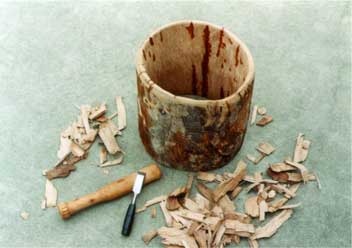
The smooth, mottled brown and white bark, along with the coarse, light green foliage, were distinctive features of the
large trees that grew along the wet soil of the stream banks.
Their barrel-shaped trunks averaged around 2 to 4 feet in diameter,
sometimes much larger. Their spreading branches reached heights
of 40 to 80 feet. These trees with the massive, stout trunks were
Platanus racemosa, commonly known as California Sycamore.
A young sycamore trunk sat on the grass in the primitive campground
near the stream. The stump measured a foot in diameter and stood
12 inches high. The
stump's relatives towered only a few yards away. The young sycamore
never got a chance to realize its full potential like its older,
sycamore siblings. A casualty of a roadside clearing, the sycamore
trunk eventually became a comfortable seat for a weary hiker.
In the interconnectedness of life, the stump also became the home
of burrowing larvas and a colony of termites.
When I came upon the stump, the termites had vacated their sycamore
home and left a labyrinth of holes and decaying wood that was
once the core. I rescued the young sycamore trunk from its unfortunate
fate and decided to breath life into the stump by transforming
it into a drum. I thought of returning someday to the same spot
with the sycamore drum so that it could sing to its towering siblings.

Find a tree trunk and hollow out the core.
If you can find a trunk that has been naturally bored through
by bugs or decay, it'll make your work easier. Otherwise, you'll
have to either carve out the center with a chisel or burn out
the core with hot coals.
The air chamber of the drum body greatly influences the sound
of the struck membrane. The deeper the chamber, the greater the
resonance.
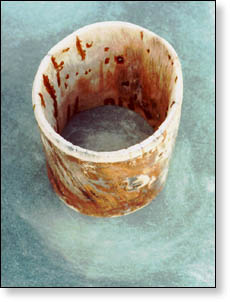
The top and bottom rim were ground smooth by abrading the stump against a flat, concrete pavement. The flatter the rim, the tighter the fit of the hide. Also slightly beveling the outer edges of the top and bottom rim will make the rawhide drumhead fit tightly.
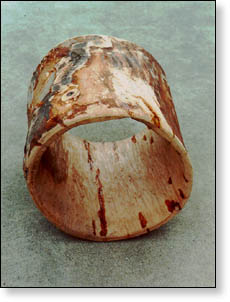
Over time, as the sycamore stump dried, it developed fissures
along the inside of the termite eaten core. I applied pine pitch
sap, that was liquified with alcohol, to the cracks. The sap solution
was reapplied and allowed to dry before continuing to the next
procedure.
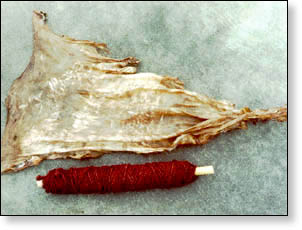
Deer rawhide was used for the two membranes and coconut coir was utilized for the lashings.
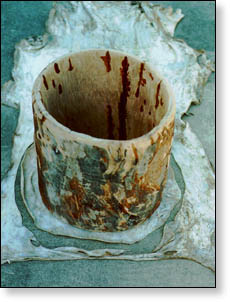
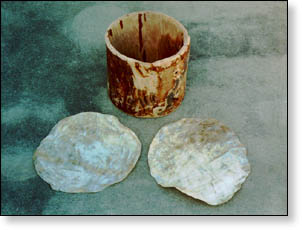
Soak the rawhide in a barrel of water for one hour or until pliable. Cut a circle of membrane that extends at least 2 inches beyond the edge of one opening. Cut out another membrane for the other opening.

Place the two membranes back to back and punch through both of the hides simultaneously. The holes were punched with an awl around the edge of the membranes at 2 inch intervals and 1 inch from the edge.
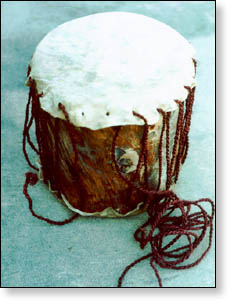
Center the bottom end of the drum body on top of its matching membrane and place the other membrane on top of the top rim of the drum. Align the holes of both membranes. Lace the rawhide drumhead. After lacing all the holes, the cordage is then pulled tight and tied.
A drumstick was made from a wild rose stalk. A groove was carved 1 inch down on the beater end. The stalk was fitted with a head of brain tanned buckskin and stuffed with buffalo hair. A buckskin thong lashed the leather head to the notched end of the wild rose stalk.

Double-headed drums entirely enclose the air chamber, but the flexibility of the second head affects the vibrating air within the chamber. A hole in the side of a double-headed drum is often made to allow air flow and therefore greater sound transmission (this is optional. If your drum sounds good, then a hole is not necessary).
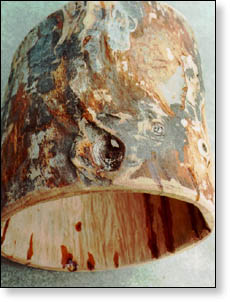
Humidity changes the resonance of drums with rawhide covers. A damp
day lowers the sound. It is not unusual for a drumhead to be heated
briefly over a fire to bring it to proper pitch.
I avoided this procedure whenever the dampness and humidity caused
the membranes of the sycamore drum to soften. The cracks on the
drum body were filled with pine pitch. Placing the sycamore drum
next to fire would have melted the pitch, thus makng a sticky mess.
When the drumhead softened from humidity, the sycamore drum was
put away until the rawhide dried.
The new drum was brought to its original
home. As the night enveloped the primitive campground, the sycamore
drum made its appearance at the campfire. Aside from the crackling
sounds of the fire, the night air was quiet and still, like the
opening night at the opera. The drumstick baton was raised and
the first booming beat of the sycamore drum echoed in the night. Its rhythm
gave it a life of its own, as if to say, "I am alive again.
Hear my voice! Hear me sing!"
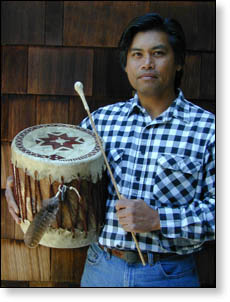
E-mail your comments to "Dino Labiste" at KahikoArts@yahoo.com
We hope the information on the PrimitiveWays website is both instructional and enjoyable. Understand that no warranty or guarantee is included. We expect adults to act responsibly and children to be supervised by a responsible adult. If you use the information on this site to create your own projects or if you try techniques described on PrimitiveWays, behave in accordance with applicable laws, and think about the sustainability of natural resources. Using tools or techniques described on PrimitiveWays can be dangerous with exposure to heavy, sharp or pointed objects, fire, stone tools and hazards present in outdoor settings. Without proper care and caution, or if done incorrectly, there is a risk of property damage, personal injury or even death. So, be advised: Anyone using any information provided on the PrimitiveWays website assumes responsibility for using proper care and caution to protect property, the life, health and safety of himself or herself and all others. He or she expressly assumes all risk of harm or damage to all persons or property proximately caused by the use of this information.
© PrimitiveWays 2013